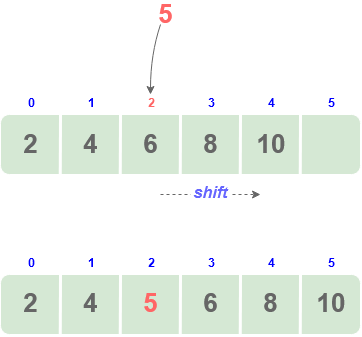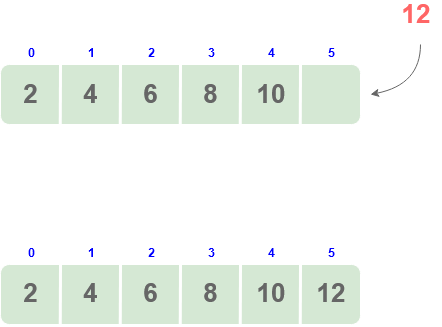Array
An array is a group of items of the same type that share a common name. The elements in an array are stored at contiguous memory locations. Each location of an element in an array is indicated by an integer known as index, which is used to identify the element. Value of index starts from 0 and goes on till size-1 where size is the number of elements present in the array. The values in the array are indicated by writing the index or subscript within square brackets after the array name.
For example, consider an array {2, 4, 6, 8, 10, 12} :

Here, the array length is 6 that means it can store 6 elements. Each element can be accessed via its index. For example, element at index 2 is 6.
Accessing elements in an Array
Representation Of Array
Arrays are generally represented as :
datatype array_name[array_size]
datatype array_name[] = {value1, vlaue2, value3};
datatype array_name[size] = {value1, vlaue2, value3}
where data-type has to be a valid data type ( int, float, char…)
name must be a valid identifier
We can create arrays of various data types :
Integer array : int arr[] = {10, 20, 30, 40, 50};
Character array :char arr[] = {‘a’, ‘b’, ‘c’, ‘d’, ‘e’};
Accessing elements
 accessing elements in array
accessing elements in array

To access elements in an array, the index or subscript is put within square brackets after the array name. : array_name[index]
For example, consider an array arr[] = {2, 4, 6, 8, 10, 12}
arr[0] gives us the first element i.e. 2,
arr[1] gives us the second element i.e. 4,
arr[5] gives us the last element i.e. 12.
Operations on Arrays
Array Traversal
This operation is to traverse through the elements of an array.
void Display() {
int size =5;
int arr[] = {2,4,6,8,10};
for(i = 0; i<size; i++) {
print(arr[i]);
}
}
Array Insertion
Insertion at the beginning of Array
For inserting at the beginning of an array, the existing element need to be shifted forward. Assume an array arr with N elements. The maximum numbers of elements it can store is defined by size.
- Check if the array has space
- If yes, then proceed with the insertion operation.
- Shift the element by one index each
- Insert the element at the first index

Code
void Insert(int val) {
//shift the elements
for(i = N; i >= 0; i--) {
arr[i+1] = arr[i];
}
// insert the new element
arr[0] = val;
N++;//increase current size of the array
}
Since inserting in the front of the array involves shifting all the elements to the right side, it has a time complexity of O(n)
Insertion at a given index
The exact location of the array where the new element needs to be inserted is provided.
- Check if the array is full
- If not, move(shift) all elements from that position one step forward to make space for the new element.
- Insert the element at the index.
- Insertion in array at given index

Code
void Insert(int position,int val) {
// Shifting rest of the elements forward
for(int i = N; i >= position; i--) {
arr[i+1] = arr[i];
}
// add new element at given position
arr[positon] = val;
N++;
}
Since inserting element in the middle involves shifting the array elements to the right side, it has a worst case time complexity of O(n)
Insertion at the end
- Check if there is space in the array
- If yes, insert array at index-1
- Increase value of N(current size)

Code
void Insert(int arr[], int size,int val,int capacity) {
// Cannot insert more elements if n is
// already more than or equal to capcity
if (n >= capacity) {
return n;
}
arr[n] = key;
return (n + 1);
}
Inserting at the end of the array doesn't involve any shifting. Therefore, it has a time complexity of O(1)
Array Deletion
Delete from beginning of array
Steps
- Check if array is empty
- traverse to the position at which the element has to be deleted
- Starting from given index, shift all elements one index backwards
- decrement the value of size

Code
int Delete(int arr[], int pos, int n) {
if (pos == - 1) {
print(Element not found);
return n;
}
// Deleting element
for (int i = pos; i < n - 1; i++) {
arr[i] = arr[i + 1];
}
return n - 1;
}
Since deletion from the beginning of array involves shifting all the elements to the left, it has a time complexity of O(n)
Deletion from a given index

Since deletion at a tiven index involves shifting the elements on the right side to left, it has a worst case time complexity of O(n)
Deletion at end in array

Since deletion at the end doesn't involve any shifting of elements, it has a time complexity of O(1)